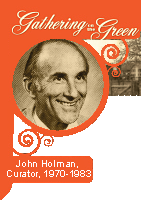In 1970 the Winnacunnet Plantation Restoration was opened on the Museum grounds, with a parade and ribbon-cutting by Governor Walter Peterson. Intended to demonstrate daily life on the seacoast in the 17th-19th centuries, the project was plagued with problems and by 1972 had lost the support of the Society. It was closed permanently after the 1973 summer season.
Other setbacks followed. The
Founders Park memorial stone for the Town of Rye had not been forgotten, but once again plans for its placement fell through. In 1977 the Society's president expressed a disappointment of another sort. 'I was struck by the lack of awareness of who the Meeting House Green Memorial and Historical Association was and where it could be located. I was further to discover that many who knew of us, and where we were, had never taken a few moments to see what we were all about.'- President Roger Garland, 1977 Hampton Town Report.
There were bright spots of progress, too. John Holman was the Museum's curator during the years 1970-1983. His dedication to organization, detail, and historical preservation still resonate in our records today. His wife Connie, whom he affectionately called 'The Commander,' also contributed to the success of the Society.
The Board of Directors took a more proactive approach to the financial future of the Society and the safety of its historical collections. Budgets were formulated and security systems installed. The road around the Museum was named 'Meeting House Green' and opened to one-way traffic only. The Green, Hussey, Emery, and Sleeper family stones were added to
Founders Park. The Society reprinted Joseph Dow's History of Hampton, with sales of the book funding improvements to Tuck House and Hall. In 1975 the Society celebrated its 50th anniversary and helped dedicate Bicentennial Park on the site of the old Coast Guard Station. With the Town, the Society celebrated the country's Bicentennial in 1976.
The Custodian for the decade was Marion Freeman. Historians were Harold Fernald (1970-1974,1978-1982) and Diana LaMontagne (1974-1978). Presidents were Samuel Towle (1968-1976), Minnie Philbrook (1976-1977), Roger Garland (1977-1978), and Leslie Cummings (1978-1981). Dues were raised to $2 per person and $3 per family. The Society ended the decade with $1,000 in the Treasury.





